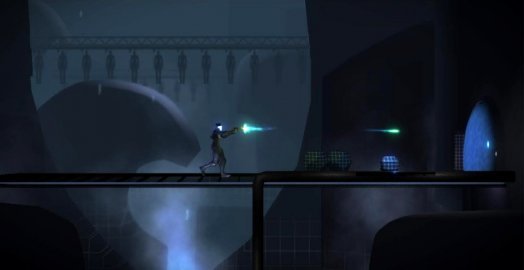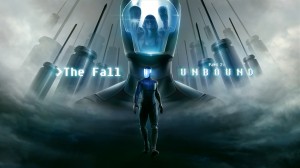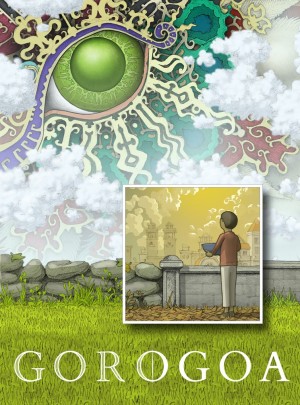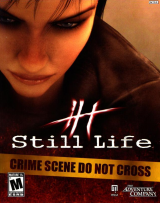Review for The Fall: Part 2 – Unbound

Game information
In their 2014 inaugural sci-fi adventure debut of The Fall, Over the Moon managed to walk a fine line, finding the sweet spot between point-and-click horror adventure and sci-fi action. Now, with the release of the tale’s second chapter, Unbound, the indie developer has elected to go into a slightly different direction. Stepping away from the light horror tropes of its predecessor, this 6-8 hour installment puts a heavier focus on action segments while telling an effective Asimovian thriller of robot psychology, though one that occasionally suffers from overly convoluted banter.
Players once again take on the role of A.R.I.D., the A.I. of a cosmonaut’s space suit designed to preserve the vital functions of its occupant, but the story this time takes on a much different bent. It has to – after the first chapter’s cliffhanger ending, how could it not? Without a person to protect in this installment, A.R.I.D.’s original function has ceased to have any meaning. So, what’s a virtual girl like her to do? Why, alter her own programming, of course, and search for a means of ridding her code of the virus that threatens to overtake her sentience, all while questioning the laws governing artificial intelligence along the way. A.R.I.D.’s new primary objective? Save herself, no matter the cost.
After an initial attack by the malevolent virus, she decides to trace it back to its source, the controller who is threatening her existence from afar. With her body – the suit she inhabited until now – rendered useless by the previous adventure, she mobilizes herself by entering the digital virtual world where she takes on a representation of her former self, once again able to run, jump, and shoot her way to her goals. This part of the game plays out a bit like a Metroidvania title: as A.R.I.D. you can directly navigate the environments, get into firefights against manifested versions of the spreading viral infection, and use server lines to “ride the rails” from terminal to terminal. Some rooms are sealed off by special-colored doors and firewalls, requiring you to backtrack occasionally once you’ve picked up a new power to open the barriers.
But A.R.I.D. isn’t alone on her quest this time around. She can send herself flying between servers located at various physical locations across the planet’s surface, but interfacing with them requires a real-world operator. Enter the Butler, One, and the Companion, three still-functioning robotic relics of humanoid appearance (and, in the case of the Companion, enough salacious details befitting her role as object of desire) left behind by time long ago. In different ways, each symbolizes the themes playing out in the game: what it means to define one’s purpose, and whether individuality should be prized above conformity. While one seeks to transcend his robotic nature by aping the arts and humanities of the humans who designed him, another wants nothing more than to serve her human masters’ every sordid wish, subjugating herself to their whims.
These three lost mechanical souls become A.R.I.D.’s unwilling hosts in her need for physical bodies. But just as A.R.I.D.’s own programming once collared her into certain behavior patterns, so her hosts also have their own unique programming to contend with. Breaking the robots from their programming becomes an interesting challenge, and although it’s done with good intentions, it is a sometimes violent act that causes its subjects mental anguish rather than blessed freedom. The first such accomplice A.R.I.D. comes across is the home robot Butler. While A.R.I.D. requires access to a computer terminal in the basement of the house he serves, the Butler – who actively attempts to keep A.R.I.D.’s virtual presence out of his body – has a set routine to follow each waking cycle, and his path does NOT include an unscheduled side trip to the basement.
Here is where Unbound’s puzzle-solving, its real meat, comes in. Each of the three hosts has their own agenda, their own programming that they cannot consciously disobey. You must find special means to align your goals with your hosts’ objectives, or, failing that, out-and-out trickery to circumvent their prime directives. This is sometimes accomplished through verbal exchanges, but more often than not by tagging along with them and subtly influencing their environment. Usually this is achieved by means of some inventory items, leading to changes in their behavior. Getting to know each of the robots’ distinct personalities, and seeing firsthand the worlds they live in, is one of this episode’s high points. For instance, it quickly becomes clear that the Butler’s master and mistress have long since passed away, and he spends his days catering to two dried-up corpses, serving tea, applying lipstick, and supplying any spoken dialog between them in his own, distorted approximation of their voices.
While this is a creative approach to traditional inventory-based design, it’s made much more complicated than it needs to be. Not all puzzle objectives are immediately clear, often communicated using the stuffy robotic-speak A.R.I.D. and her hosts communicate in. Listening to two robots attempt to talk about everyday objects and processes with their cold, surgically precise language can make deciphering the puzzles, and even the plot at times, especially difficult. During the game’s final act, the challenge spikes once again, as all three of the hosts’ personalities can be interchanged with each other. In other words, it becomes possible to view the Butler’s world through the eyes of the Companion, changing all the text-based item interactions to reflect their new observer’s viewpoints. This includes obstacles which, at that late stage, are only solvable when examined through one particular point of view. The possible combinations are vast, making the already tricky-to-decode puzzles even harder.
At least guiding A.R.I.D. or one of her cohorts through the game has been simplified. The side-scrolling movement is still handled via the WASD keys and aiming with the mouse. A quick mouse-click toggles between combat and exploration mode, one using the gun to shoot, the other using its built-in flashlight cone to detect objects in its path. But interacting with hotspots and using items requires less awkward mouse-and-keyboard manipulation than before, accomplished by simply shining the flashlight on it, then cycling through several pop-up icons using the keyboard. Still, the control scheme is more of a hassle than is necessary during particularly frustrating puzzle sections, demanding an overabundance of finger gymnastics when resorting to the “try everything on every object” technique.
Combat has been given a much larger focus this time around, with frequent battle sequences and even a traditional action set piece against the game’s final boss to contend with. Thankfully Unbound employs an auto-aim feature, so you really just have to focus on side-to-side movement and jumping to evade an opponent’s attacks, firing A.R.I.D.’s sidearm when its guard is down. There are also several hand-to-hand fighting sections, as one character is skilled in martial arts, though these are simplified by being boiled down to “Left Attack/Right Attack” rhythm game sections. Though simple in concept, the escalating difficulty of these sections will likely require a number of retries, each failure kicking you back to the most recent checkpoint. The combat is rarely challenging enough to become frustrating, it just doesn’t add much to the game’s overall entertainment value, and quickly pops up at predictable intervals, seemingly as a way to pad the play time out a little more.
Much like in The Fall’s previous entry, the austere, empty planet environment A.R.I.D. finds herself stranded on is as much a character as the rest of the cast, whether alive in the traditional sense of the word or otherwise. Though there is more variety to the locations this time around – the Butler resides in a spacious mansion, One spends his time meditating in a tranquil temple of his own design, the Companion practices her craft aboard a spacecraft floating in orbit – there is still the same overwhelming feeling of loneliness that pervades throughout. This isn’t a happy, shiny fantasy world.
Questions carried over from Part 1 (What happened on this planet? Is there some nefarious history behind the now-defunct mass robot production facility?) still remain by the time the credits roll, though they are at least somewhat expanded upon during the course of events and by reading some of the computer logs left behind by previous human inhabitants. The grim, moody, sometimes adult atmosphere is carefully constructed and executed to great effect when it starts to almost physically press down upon you, oppressive and heavy.
The virtual space A.R.I.D. travels through is only slightly lighter in tone, yet as alien and unknowable as the rest of the game. Sadly, while this could have easily been one of Unbound’s most outstanding components, there is a little lost in translation. The narrative is too focused on A.R.I.D.’s hunt for her tormentor to shine much light on this world, and when it does offer small nuggets of background, they often come across as garbled and incomprehensible walls of technical text written by scientists and engineers with PhDs in computer programming and other such jargon-centric fields.
As relentlessly bleak as The Fall’s dystopian future is, it nevertheless sports some nice artwork and animation, though its visual tone is carefully selected to enhance the desolation players are meant to feel. The landscape – what little you get to see of it – is a stark wasteland, the environments generally dimly-lit with carefully-placed splashes of color. Yet despite being drenched in darkness, the backgrounds do have a nice level of visual detail, like the production facility’s row upon row of offline yet no less menacing robots hanging from racks, or the storm raging outside the Butler’s mansion, with pelting rain and lightning flashes visible through the many windows. The four protagonists’ movements are also animated nicely with fluid motions. This is especially evident in the martial arts sequences, when the screen routinely zooms in on a slow-motion combat moment, really highlighting the attention that went into animating these battle scenes.
Music and sound effects are incorporated into the overall atmosphere in commendable ways. The characters’ robotic clanking and whirring mixes naturally with the zaps and crashes of metal-on-metal combat; the mundane noise of the real world juxtaposed against the completely alien virtual world, where beings can shoot absorbed pulses of energy at viral manifestations and travel along server paths instantaneously. Music is chosen well, with an industrial cacophony during action scenes, while moments of repose or melancholy are often accompanied by somber classical piano compositions that players will instantly recognize. The game is also fully voiced, with a generally favorable result. It’s just too bad that the verbal exchanges, no matter how competently performed, sometimes devolve into the realm of nonsense when the characters drone on in hard-to-interpret robot lingo.
Ultimately, Unbound does a fine job in carrying on The Fall’s ongoing narrative. Not content to retread the same ground, the sequel mixes in new characters while stepping away from its predecessor’s horror vibe, embracing its action elements more fully. But the core of the game comes from the evolution of its main protagonists: where the first chapter explored the lengths an artificial intelligence might go to serve others, this installment deals with what comes next – where does artificial end and self-serving intelligence begin? It’s an admirable topic to see tackled, and has merit, so it's a shame the narrative is brought down some by being too obtuse for its own good, with technical terminology and deliberately awkward speech patterns to work through. This insistence on muddying up the language even bleeds over into the puzzle-solving, occasionally masking objectives unnecessarily. On the whole, though, The Fall: Part 2 is still an enjoyable and unique experience, and paves the way forward for the eventual conclusion to the trilogy.
WHERE CAN I DOWNLOAD The Fall: Part 2 - Unbound
The Fall: Part 2 - Unbound is available at:
- GOG -80%
- Steam
- Epic Games
- HumbleBundle



























